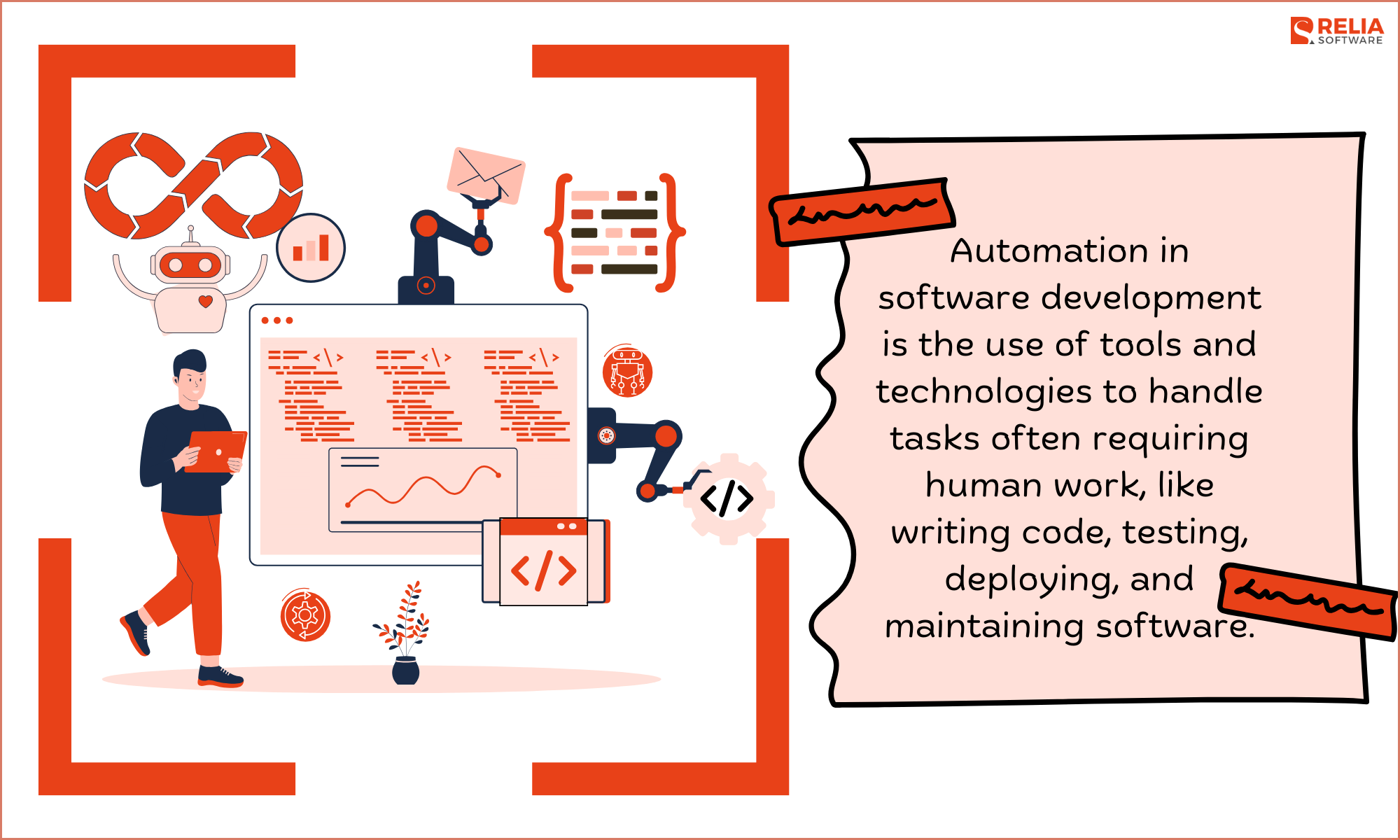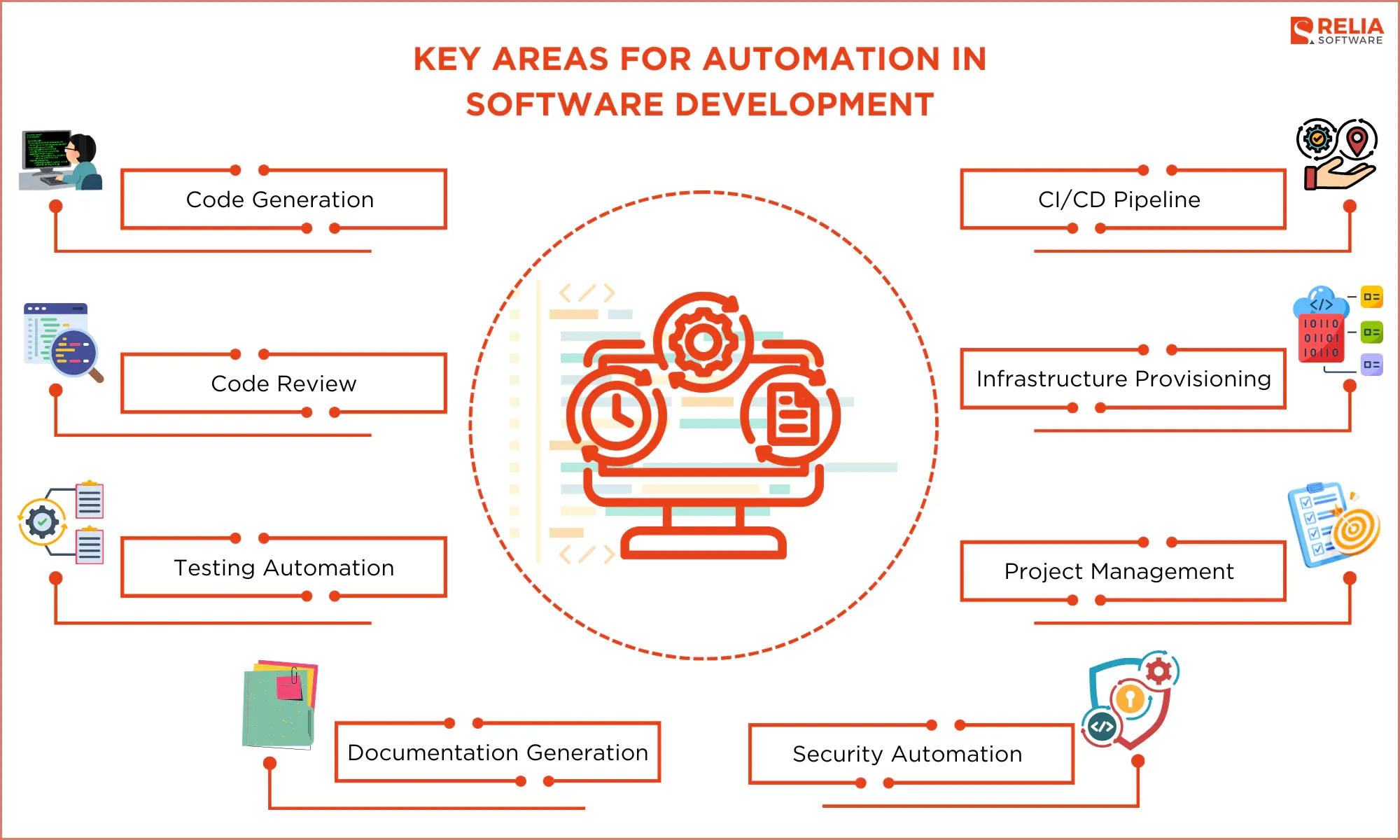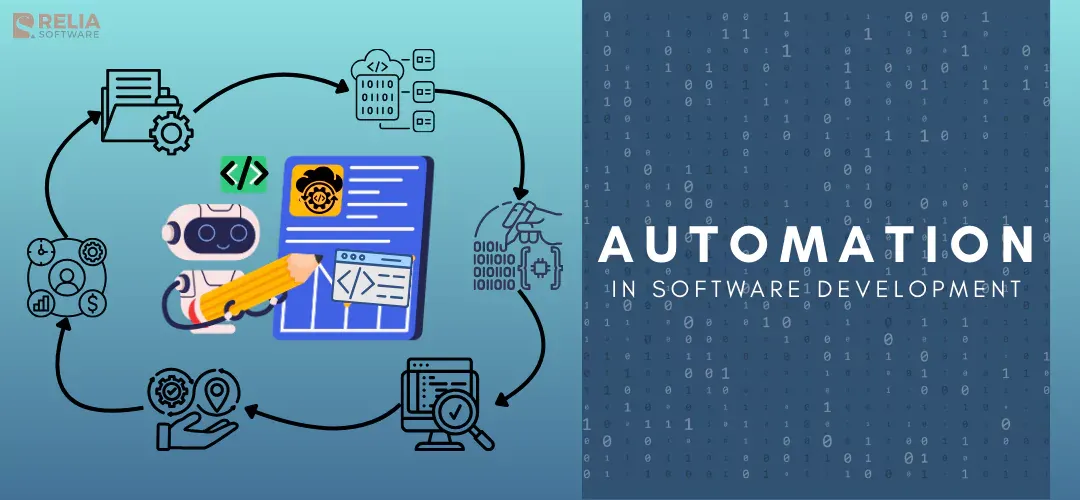Automation is transforming app development, testing, and deployment. Automating tedious tasks lets developers tackle bigger, more creative problems. Advanced technologies like AI make automation vital for faster and more scalable software development.
To maximize its potential, setup expenses and system integration must be handled. We'll go over each aspect of automation in software development in this blog, so you may use to streamline your processes.
What is Automation in Software Development?
Automation in software development is the use of tools and technologies to handle tasks often requiring human work, like writing code, testing, deploying, and maintaining software. By automating these chores, development teams can cut error rates, minimize repetitive work, and increase general output.
Through handling repeated activities, automation simplifies the software development life cycle. You know, developers may thus focus on more important tasks like designing products or handling challenges. Since tools follow coding standards, automation guarantees consistency as well; so, there are fewer mistakes or unanticipated human adjustments.
In short, automation makes software development faster, more reliable, and more efficient, leading to higher-quality software that can be delivered in less time.

Key Areas for Automation in Software Development
Code Generation
You can use tools that automatically generate code from predefined templates or patterns instead of writing yourself to speed up development. This makes tasks like generating boilerplate code or standardizing complex structures much faster and more efficient by eliminating human coding. Automated technologies also make the whole project consistent by adhering to coding standards and best practices.
>> You may interested in: Cursor vs Copilot: Which is A Better AI-Powered Coding Tool?
How Code Generation Works?
Code generation creates functional code from templates, specifications, or high-level descriptions. It can work in some main ways:
- Template-Based Generation: Predefined templates are filled with details like variable names, functions, or data types.
- AI-Powered Generation: AI technologies learn from large codebases to recommend relevant code snippets by analyzing context or natural language input.
- Model-Driven Engineering: This approach uses models representing system architecture, which are then translated into source code. It’s useful for maintaining consistency in complex system designs
Popular tools for automating code generation include:
- GitHub Copilot: An AI-driven assistant that suggests code snippets based on context, helping developers work faster.
- Tabnine: Similar to Copilot, Tabnine predicts and generates code snippets, improving efficiency by automating repetitive tasks.
- JHipster: Creates code for project setup and integrates with major frameworks like Java and Angular, therefore scaffolding whole applications.
- Spring Boot Initialize: Quickly generates the basic structure for Spring Boot projects, minimizing setup time for Java developers.
- Yeoman: A flexible tool for creating boilerplate code for web, mobile, and other projects.
>> Read more: Benefits of Artificial Intelligence (AI) in Mobile App Development
Code Review
Code reviews make sure code meets quality standards before being added to the main project. This procedure is automated by using tools that find bugs, security risks, and coding standards breaches.
Automating code reviews helps teams catch errors early in development, lowering the risk of bugs in production. It also ensures the code follows best practices, making the software more maintainable and safe.
How Code Review Automation Works?
Rules and patterns are used in automated code review. These tools aid:
- Static Code Analysis: Reviews code without running it, catching issues like syntax errors, unused variables, and security risks.
- Security Scanning: Detects vulnerabilities, such as insecure data handling or weak access controls, to prevent security breaches.
- Style Enforcement: Ensures that codes follow style guidelines and best practices, therefore enhancing uniformity and readability.
During the code review process, the tool scans the code and provides feedback, often as inline comments, highlighting issues that need to be addressed. Developers then can fix these issues and resubmit the code for review.
Several tools help automate code reviews:
- SonarQube: A popular static code analysis tool that finds bugs, security vulnerabilities, and code quality issues. For ongoing code quality monitoring, it integrates easily with CI/CD pipelines and supports multiple languages.
- Codacy: Automates reviews by providing insights on code quality, security, and style adherence. Appropriate for development processes, it supports several languages and integrates readily with Git repositories.
- ESLint: Primarily for JavaScript, ESLint enforces coding standards and catches errors early in development, improving code quality and consistency.
- Checkstyle: Designed for Java, Checkstyle guarantees coding standards are followed, hence preserving a consistent and clean codebase.
>> Read more:
- Top 10 Automated Code Review Tools For Developers
- AI in Software Testing: How It Works, Benefits & Challenges
Testing Automation
Testing automation automatically executes tests to validate functionality, performance, and security. Instead of manually running tests, automated testing tools handle repetitive test scenarios, freeing up time for developers to focus on more complex testing or feature development.
Testing automation reduces the risk of human error, speeds up the testing process, and enables continuous testing throughout the software development lifecycle. In regression testing, this is especially useful because previous features need to be reexamined because of code changes.
How Testing Automation Works?
Testing automation involves creating scripts that simulate user actions or check specific parts of the code. You run these scripts automatically by using testing tools, then these tools compare the actual results to the expected ones. Unit testing, integration testing, UI testing, performance testing, etc. are among the several kinds of tests for which automation is possible.
Testing Automation Tools:
- Selenium: A popular tool for automating web browser testing. It simulates user interactions with web applications across multiple browsers, making it a go-to choice for UI testing.
- JUnit: A framework that is widely used for unit testing in Java lets developers create and run tests for individual code components.
- TestComplete: Supports UI and functional testing for both desktop and web applications, offering robust features for automated testing across different environments.
- Cypress: A modern tool for web applications that focuses on end-to-end testing to assess whole user flows in real-world scenarios.
CI/CD Pipeline
Modern software development requires CI and CD automation.
- CI automatically merges code updates from different developers into a shared repository numerous times a day so that teams spot issues early and fix them swiftly.
- CD automatically deploys these code changes to production environments after they pass all necessary tests.
In short, CI and CD speed up software releases and increase dependability, therefore shortening development and deployment time.
How CI/CD Works?
CI/CD works by automating the process of building, testing, and deploying code. Here’s how it works:
- Continuous Integration (CI): Every time a developer commits code to the repository, automated tests and builds are triggered. This ensures that the new code integrates smoothly with the existing codebase and that no new bugs are introduced. If a problem arises, the CI system instantly notifies the developer so they may fix it before forwarding progress.
- Continuous Deployment (CD): Once the code passes all tests in the CI pipeline, it is automatically deployed to production or staging environments. So, there's no need for manual deployments, errors are thus reduced, and new features and fixes are faster to users.
Several automation tools streamline CI/CD processes:
- Jenkins: Popular tool for automating code building, testing, and deployment. With many plugins for workflows and environments, Jenkins is highly adaptable.
- CircleCI: A cloud-based CI/CD tool that integrates with version control systems like GitHub and Bitbucket. CircleCI automates builds, tests, and deployments, giving developers fast feedback.
- GitLab CI/CD: Integrated into GitLab, this tool automates the entire DevOps lifecycle, from code commits to production deployment, with built-in version control and CI/CD pipelines.
- Travis CI: A basic CI service for GitHub projects, often chosen for open-source development due to simple CI/CD setup and management.
>> Read more:
- CI/CD vs DevOps: Key Differences & How They Work Together?
- Top 9 Best DevOps Deployment Tools for Businesses
- Top 22 Best DevOps Automation Tools For Businesses 2024
Infrastructure Provisioning
The configuration of IT resources, such as servers, networks, and storage, required to operate applications is known as infrastructure provision. This was done manually in the past; but, automation tools have made it far faster and more effective.
A key part of automating infrastructure provisioning is Infrastructure as Code (IaC). IaC manages infrastructure using codes, therefore simplifying tracking of changes, teamwork, and regular deployment. This method guarantees consistency, saves time, and lets infrastructure be updated faster, more dependable.
How Infrastructure Provisioning Works?
Automated infrastructure provisioning works by using predefined templates or scripts to create and configure infrastructure resources. Here’s how it typically operates:
- Infrastructure as Code (IaC): IaC tools allow teams to define infrastructure in code files, which can then be automatically deployed. Storage allocations, network configurations, and server setups are specified in these scripts.
- Templates and Modules: Provisioning tools use templates or modules to standardize resource configurations. These can be reused across different environments to maintain consistency.
- Automated Execution: The infrastructure code can be executed automatically to generate or update resources in cloud or on-premises settings, ensuring consistent and dependable provisioning.
Infrastructure Provisioning Tools:
- Terraform: A versatile Infrastructure as Code (IaC) tool that works across multiple cloud providers like AWS, Azure, and Google Cloud.
- AWS CloudFormation: Automates AWS resource setup using infrastructure as code for consistent deployments.
- Ansible: An open-source tool for automating provisioning, configuration management, and application deployment with easy-to-use YAML files.
- Chef: Automates infrastructure management and provisioning, ensuring resources match the desired state through code-based configurations.
Project Management
Software project planning, tracking, and execution are simplified by project management automation. Project management solutions simplify team organization and scheduling by automating work assignment, progress tracking, and reporting. Automation frees managers to focus on strategy and decision-making while aligning teams and meeting deadlines.
Task scheduling, resource allocation, time tracking, and communication channels are typically integrated into automated project management tools. These solutions enhance teamwork, transparency, and savings over manual project tracking.
Project Management Tools
- Jira: Automates task tracking, sprint planning, and bug tracking, so development teams stay organized and agile.
- Asana: A flexible project management tool, Asana automatically tracks progress, assigns tasks, and reports. It’s user-friendly and works well for teams of all sizes.
- Trello: Uses visual boards to simplify progress tracking and real-time collaboration with automated task updates and notifications.
>> Read more: How To Manage A Software Development Team? 11 Useful Strategies
Documentation Generation
A very important but often forgotten part of making software is writing documentation. It involves creating and maintaining accurate details about the software's features, API endpoints, and configuration. Automating documentation generation minimizes human labor and guarantees that the documentation stays up to date with the codebase as it changes.
How Documentation Generation Works?
Automated documentation tools work by:
- Code Parsing: Scanning the source code to extract data like comments, function definitions, and code structure.
- Formatting: After the data has been extracted, it is formatted into easily readable documentation, usually in Markdown, HTML, or other formats that are suitable for documentation.
- Updating: The documentation is automatically updated whenever the code changes to keep it accurate and currency.
Popular Documentation Generation Tools:
- Sphinx: Mostly for Python projects, Sphinx creates orderly documentation from code comments and docstrings.
- Swagger: Creates interactive API documentation straight from your code, so you can test API endpoints easily.
- Doxygen: Provides comprehensive documentation, including call graphs and class hierarchies, and supports a number of languages.
- JSDoc: Designed for JavaScript, it creates clear API documentation from code comments.
Security Automation
Security automation involves using tools and technologies to automatically detect, analyze, and respond to security threats throughout the software development lifecycle.
As cyberattacks get increasingly complex, security automation monitors vulnerabilities, ensures compliance, and applies security policies to protect applications. Automating these tasks allows development teams to spot and fix security risks in real time, reducing the risk of breaches and ensuring protection across the codebase.
How Security Automation Works?
Code vulnerability scanning, configuration monitoring, and security policy enforcement are automated in the development pipeline.
- Static and Dynamic Analysis: Automated tools perform static code analysis to find security vulnerabilities before the code is executed and dynamic analysis to test running applications for potential threats.
- Automated Patching: After detecting vulnerable components, security tools can automatically patch or upgrade them.
- Continuous Monitoring: These tools continuously detect security breaches and alert teams to unusual activities in the application environment.
Security Automation Tools:
- Snyk: A tool that automatically scans for vulnerabilities in code, dependencies, and container images, helping developers fix issues early in the development cycle.
- Trivy: As an open-source vulnerability scanner for containers, Kubernetes, and other infrastructure, it automates detecting code and infrastructure security risks.
- Veracode: Automated security testing of both static and dynamic applications to identify and address issues.
- Aqua Security: Focuses on protecting containerized applications by implementing security policies throughout the CI/CD process.

>> You may consider:
- Top 7 Web App Security Testing Tools For Developers
- Top 14 Best Data Security Software For Your Businesses
- An Ultimate Guide To Web Application Security for Businesses
- What is DevSecOps? 4 Steps To Integrate Security into DevOps
Benefits of Automation in Software Development
Development teams can work quicker, smarter, and better with automation. Some important benefits are:
- Save Time: Automate repetitive chores to free developers to work creatively and strategically without wasting time on tedious tasks.
- Improve Quality: Automation reduces human errors and guarantees code consistency. Earlier detection of issues by automated code testing and review also improves software quality without costly fixes later.
- Boost Productivity: Without manual duties in boring tasks, developers may be more creative and productive.
- Reduce Costs: Automation boosts efficiency and reduces the need for manual work, costly fixes, downtime, or rework, saving money over time.
- Improve Scalability: Automation helps development teams handle larger projects and grow.
- Enhance Collaboration: Automated tools can make it easier for teams to work together and share information.
Challenges of Automation in Software Development
- Complex Setup: Setting up automation needs a strong understanding of the development process and tools. Without proper setup, automation might cause more issues than it solves.
- High Upfront Costs: While automation saves money over time, the initial costs for tools, infrastructure, and training can be high, a barrier for smaller teams or startups.
- Integration Challenges: Not all tools work smoothly with existing systems, which can lead to compatibility problems and extra effort to fix them.
- Ongoing Maintenance: Automation requires ongoing maintenance. Constant upgrades and maintenance can increase burden as software improves.
- Resistance to Change: Some team members favor manual procedures to automation due to job insecurity or new tool trust.
These issues need careful planning, investment, and a willingness to adapt to new workflows.
Best Practices for Automation in Software Development
Start Small and Scale Gradually
When implementing automation, begin with small, well-defined tasks, such as unit testing or code formatting. Increase your automation efforts gradually to more challenging areas such infrastructure provisioning and continuous integration. This helps your staff to get at ease using the tools and procedures, therefore lowering the chance of overburden and errors.
Choose the Right Tools for Your Needs
Not all automation tools are created equal. Choose tools that fit your specific requirements and integrate well with your existing systems. When choosing your automation solutions, weigh elements including scalability, community support, and simplicity of use.
Prioritize Maintenance and Updates
Automation isn't a one-time setup. Continuously monitor and update your automation scripts and pipelines as your software evolves. You know why? Regular maintenance helps your automation processes stay effective and adapt to changing development environment.
Foster a Culture of Automation
Try to persuade your staff to use automation by emphasizing its benefits, such as reduced repetitive tasks and increased productivity. You need to help and train your members so that everyone will be confident using automated tools. Finally, make automation a core part of your development workflow.
Focus on Security
Integrate security checks into your automation pipeline to catch vulnerabilities early. To deliver secure software, continuous integration and deployment should include automated security testing like static code analysis and dependency scanning.
These best practices can help your team deploy automation properly to boost quality and reduce risks.
Future Trends in Automation in Software Development
- AI-Powered Automation: AI continues to advance, playing a bigger role in automating tasks. AI-driven tools will get smarter with advancements in natural language processing (NLP), machine learning (ML), and deep learning. This enables better context understanding, issue prediction, and process optimization.
- Low-Code/No-Code Platforms: These platforms make software development more accessible by allowing users, even non-developers, to build applications with little or no coding. More individuals will be able to automate procedures without programming skills as they evolve.
- Hyperautomation: Hyperautomation combines multiple technologies like AI, robotic process automation (RPA), and process mining to automate complex, end-to-end processes across an organization, reducing the need for manual intervention.
- Intelligent Automation: Automation systems are becoming smarter with AI and machine learning, allowing them to adapt, learn, and improve as conditions change.
- Edge Computing and Automation: As edge computing grows, automation is moving closer to data sources, enabling real-time decision-making and faster response times. This is particularly important for IoT applications, where data needs to be processed and acted on instantly.
>> Read more:
- Top 12 No-code App Builders for Businesses in 2024
- No-Code And Low-Code Solutions In Logistics And Supply Chain
- Top 5 Best Generative AI Tools in 2024
Final Thoughts
For developers, automation in software development is like a super hero; it handles repetitious chores so they may concentrate on what actually counts. It helps them work faster, avoid mistakes, and deliver better-quality software.
As AI and automation continue to advance, we’ll see even more innovative tools that make development easier and more efficient. Embracing automation helps teams stay competitive in a fast-changing industry.
That said, automation must be applied wisely. Dependency on it too much without enough oversight could cause issues. Planning and monitoring are essential to ensure automation helps development rather than creates new issues. In short, best results come from balancing automation and human input.
>>> Follow and Contact Relia Software for more information!
- automation
- Mobile App Development
- Web application Development
- development
- mobile applications
- testing

